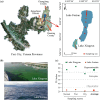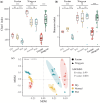Extreme trophic tales: deciphering bacterial diversity and potential functions in oligotrophic and hypereutrophic lakes
- PMID: 39277721
- PMCID: PMC11401395
- DOI: 10.1186/s12866-024-03488-x
Extreme trophic tales: deciphering bacterial diversity and potential functions in oligotrophic and hypereutrophic lakes
Abstract
Background: Oligotrophy and hypereutrophy represent the two extremes of lake trophic states, and understanding the distribution of bacterial communities across these contrasting conditions is crucial for advancing aquatic microbial research. Despite the significance of these extreme trophic states, bacterial community characteristics and co-occurrence patterns in such environments have been scarcely interpreted. To bridge this knowledge gap, we collected 60 water samples from Lake Fuxian (oligotrophic) and Lake Xingyun (hypereutrophic) during different hydrological periods.
Results: Employing 16S rRNA gene sequencing, our findings revealed distinct community structures and metabolic potentials in bacterial communities of hypereutrophic and oligotrophic lake ecosystems. The hypereutrophic ecosystem exhibited higher bacterial α- and β-diversity compared to the oligotrophic ecosystem. Actinobacteria dominated the oligotrophic Lake Fuxian, while Cyanobacteria, Proteobacteria, and Bacteroidetes were more prevalent in the hypereutrophic Lake Xingyun. Functions associated with methanol oxidation, methylotrophy, fermentation, aromatic compound degradation, nitrogen/nitrate respiration, and nitrogen/nitrate denitrification were enriched in the oligotrophic lake, underscoring the vital role of bacteria in carbon and nitrogen cycling. In contrast, functions related to ureolysis, human pathogens, animal parasites or symbionts, and phototrophy were enriched in the hypereutrophic lake, highlighting human activity-related disturbances and potential pathogenic risks. Co-occurrence network analysis unveiled a more complex and stable bacterial network in the hypereutrophic lake compared to the oligotrophic lake.
Conclusion: Our study provides insights into the intricate relationships between trophic states and bacterial community structure, emphasizing significant differences in diversity, community composition, and network characteristics between extreme states of oligotrophy and hypereutrophy. Additionally, it explores the nuanced responses of bacterial communities to environmental conditions in these two contrasting trophic states.
Keywords: Bacterial diversity; Hypereutrophic; Lake Fuxian; Lake Xingyun; Network complexity and stability; Oligotrophic.
© 2024. The Author(s).
Conflict of interest statement
The authors declare no competing interests.
Figures







Similar articles
-
Distinct ecological niches and community dynamics: understanding free-living and particle-attached bacterial communities in an oligotrophic deep lake.Appl Environ Microbiol. 2024 Jul 24;90(7):e0071424. doi: 10.1128/aem.00714-24. Epub 2024 Jun 28. Appl Environ Microbiol. 2024. PMID: 38940583 Free PMC article.
-
Beyond the Bloom: Unraveling the Diversity, Overlap, and Stability of Free-Living and Particle-Attached Bacterial Communities in a Cyanobacteria-Dominated Hypereutrophic Lake.Microb Ecol. 2024 Jul 24;87(1):96. doi: 10.1007/s00248-024-02410-2. Microb Ecol. 2024. PMID: 39046558 Free PMC article.
-
Synechococcus diversity along a trophic gradient in the Osterseen Lake District, Bavaria.Microbiology (Reading). 2016 Dec;162(12):2053-2063. doi: 10.1099/mic.0.000389. Epub 2016 Nov 1. Microbiology (Reading). 2016. PMID: 27902440
-
Pyrosequencing analysis of bacterial communities in Lake Bosten, a large brackish inland lake in the arid northwest of China.Can J Microbiol. 2016 Jun;62(6):455-63. doi: 10.1139/cjm-2015-0494. Epub 2016 Jan 18. Can J Microbiol. 2016. PMID: 27045804
-
The Bacterial Genus Ramlibacter: Betaproteobacteria Capable of Surviving in Oligotrophic Environments Thanks to Several Shared Genetic Adaptation Traits.Environ Microbiol. 2025 Feb;27(2):e70059. doi: 10.1111/1462-2920.70059. Environ Microbiol. 2025. PMID: 39987915 Free PMC article. Review.
Cited by
-
Microbial Community Structure in the Taklimakan Desert: The Importance of Nutrient Levels in Medium and Culture Methods.Biology (Basel). 2024 Oct 6;13(10):797. doi: 10.3390/biology13100797. Biology (Basel). 2024. PMID: 39452106 Free PMC article.
References
-
- Adrian R, Hessen DO, Blenckner T, Hillebrand H, Hilt S, Jeppesen E, et al. Environmental impacts—Lake ecosystems. In: Quante M, Colijn F, editors. North Sea Region Climate Change Assessment. Cham: Springer International Publishing; 2016. pp. 315–40.
MeSH terms
Substances
Grants and funding
LinkOut - more resources
Full Text Sources
Miscellaneous

